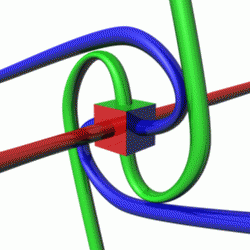Spin (physics)
== Spin (physics) ==
Spin is a fundamental property of elementary particles, atomic nuclei, and atoms. It is a form of angular momentum that is intrinsic to particles, meaning it is not due to the particle's motion through space but rather an inherent characteristic. Spin is a key concept in quantum mechanics and plays a crucial role in the behavior of particles at the quantum level.
Quantum Mechanics and Spin[edit | edit source]
In quantum mechanics, spin is described by a quantum number, which can take on half-integer or integer values. For example, electrons, protons, and neutrons have a spin of 1/2, while photons have a spin of 1. The spin quantum number determines the particle's magnetic moment and its behavior in a magnetic field.
The concept of spin was first introduced by Wolfgang Pauli in 1924 to explain the Zeeman effect, which is the splitting of spectral lines in the presence of a magnetic field. Later, Paul Dirac provided a theoretical foundation for spin with his Dirac equation, which describes the behavior of fermions.
Spin and Statistics[edit | edit source]
Particles with half-integer spin are known as fermions and obey the Pauli exclusion principle, which states that no two fermions can occupy the same quantum state simultaneously. This principle is responsible for the structure of the periodic table and the stability of matter.
Particles with integer spin are known as bosons and obey Bose-Einstein statistics. Unlike fermions, bosons can occupy the same quantum state, which leads to phenomena such as Bose-Einstein condensation.
Measurement of Spin[edit | edit source]
The measurement of spin is typically performed using techniques such as Stern-Gerlach experiments, which involve passing particles through a non-uniform magnetic field. The deflection of the particles provides information about their spin states.
Applications of Spin[edit | edit source]
Spin has numerous applications in various fields of physics and technology. In solid-state physics, the concept of spintronics exploits the spin of electrons to develop new types of electronic devices. In nuclear magnetic resonance (NMR) and magnetic resonance imaging (MRI), the spin of nuclei is used to obtain detailed images of the internal structure of materials and biological tissues.
Related Pages[edit | edit source]
Search WikiMD
Ad.Tired of being Overweight? Try W8MD's physician weight loss program.
Semaglutide (Ozempic / Wegovy and Tirzepatide (Mounjaro / Zepbound) available.
Advertise on WikiMD
|
WikiMD's Wellness Encyclopedia |
| Let Food Be Thy Medicine Medicine Thy Food - Hippocrates |
Translate this page: - East Asian
中文,
日本,
한국어,
South Asian
हिन्दी,
தமிழ்,
తెలుగు,
Urdu,
ಕನ್ನಡ,
Southeast Asian
Indonesian,
Vietnamese,
Thai,
မြန်မာဘာသာ,
বাংলা
European
español,
Deutsch,
français,
Greek,
português do Brasil,
polski,
română,
русский,
Nederlands,
norsk,
svenska,
suomi,
Italian
Middle Eastern & African
عربى,
Turkish,
Persian,
Hebrew,
Afrikaans,
isiZulu,
Kiswahili,
Other
Bulgarian,
Hungarian,
Czech,
Swedish,
മലയാളം,
मराठी,
ਪੰਜਾਬੀ,
ગુજરાતી,
Portuguese,
Ukrainian
Medical Disclaimer: WikiMD is not a substitute for professional medical advice. The information on WikiMD is provided as an information resource only, may be incorrect, outdated or misleading, and is not to be used or relied on for any diagnostic or treatment purposes. Please consult your health care provider before making any healthcare decisions or for guidance about a specific medical condition. WikiMD expressly disclaims responsibility, and shall have no liability, for any damages, loss, injury, or liability whatsoever suffered as a result of your reliance on the information contained in this site. By visiting this site you agree to the foregoing terms and conditions, which may from time to time be changed or supplemented by WikiMD. If you do not agree to the foregoing terms and conditions, you should not enter or use this site. See full disclaimer.
Credits:Most images are courtesy of Wikimedia commons, and templates, categories Wikipedia, licensed under CC BY SA or similar.
Contributors: Prab R. Tumpati, MD



